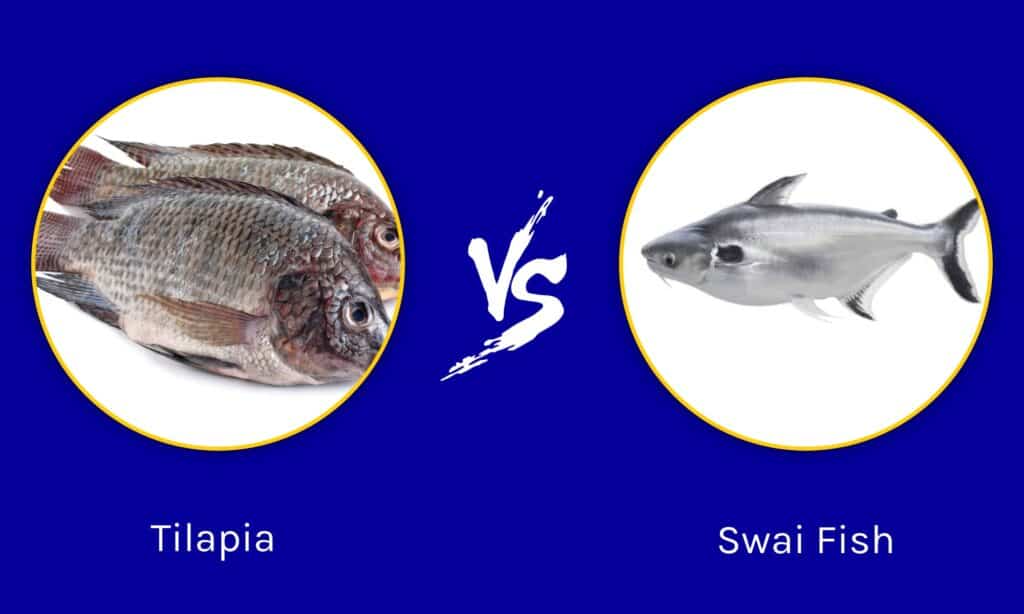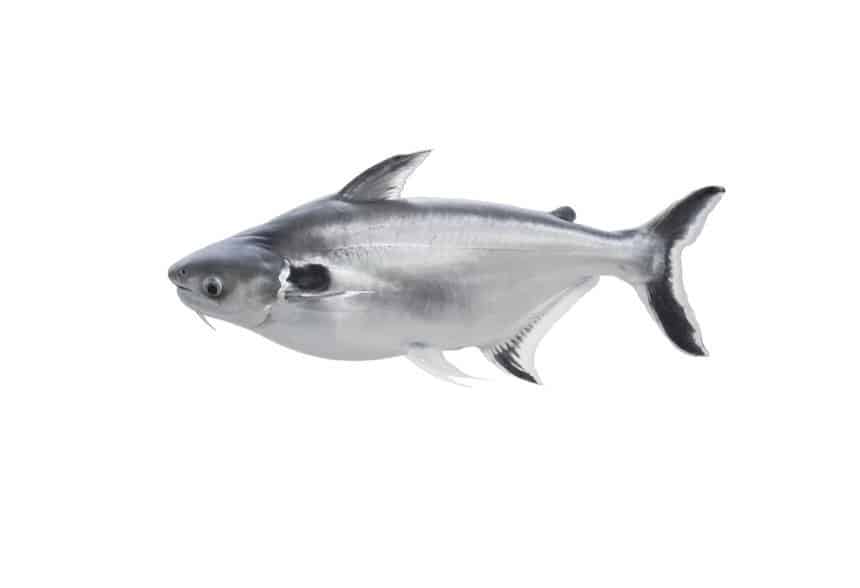Did you hear the rumors about tilapia?
There was a myth that tilapia was an artificial fish. But that’s not true! Similar to swai fish, tilapia is a naturally occurring fish. They’re native to bodies of water throughout the Middle East and Africa.
Both swai and tilapia have a delightful flaky texture, white flesh color, and neutral smell. However, even though these fish might taste similar, they live very different lives in the wild.
Read on to learn all about the differences between swai fish vs tilapia.
Comparing Swai Fish vs Tilapia

| Swai Fish | Tilapia | |
|---|---|---|
| Scientific classification | Pangasianodon hypophthalmus | Oreochromis niloticus (Nile Tilpaia) |
| Diet | Omnivore Bottom Feeder: prefers foraging along ocean substrate | Omnivore Filter Feeder: mucus traps plankton Larval fish Decomposing plant matter Phytoplankton heavy diet |
| Appearance | Weighs between 50-100 lb Can grow to be 4 feet long Silver scales Light beige skin Short whiskers Iridescent glowing dorsal fin | Size depends on environment Nile tilapia have vertical bands Blue tilapia have ununiformed bands Mozambique tilapia have light bands Male Nile tilapia tend to have gray and pink pigmentation on their throat |
Key Differences Between Swai Fish vs Tilapia
The key differences between swai fish vs tilapia include their scientific classification, conservation status, diet, and appearance.
The scientific name for swai fish is Pangasianodon, and the scientific name for Nile tilapia is Oreochromis niloticus. Some species of tilapia are considered endangered in the wild, as are wild swai fish. Their diet also introduces some similarities and differences.
Even though swai fish and tilapia are both omnivores, they have different ways of finding food. Swai fish are bottom feeders hanging out on the ocean substrate. Tilapia fish has a unique filtering system to take advantage of mid-water meals. Keep reading to dive deeper into the differences between swai fish vs tilapia.
Swai Fish vs Tilapia: Scientific Classification

The scientific name for tilapia fish is Oreochromis niloticus
©Yossi James/Shutterstock.com
The scientific name for swai fish is pangasianodon hypothalamus. They’re often known as the iridescent sharks, although they’re not actually related to sharks in any way.
Scientists put swai fish in the class of Actinopterygii, with the order of Siluriformes. Siluriformes include a group of freshwater fish, such as catfish. The order also extends to include fish that live in brackish water.
Finally, swai fish belong to the family Pangasiidae and the genus Pangasianodon. The genus helps you understand animals that are closely related to swai fish.
The scientific name for Nile tilapia fish is Oreochromis niloticus. They also belong to the Animalia kingdom and the Chordata phylum. However, tilapia are part of the animal class Actinopterygii and the order Cichliformes.
Actinopterygii includes ray-finned fish, making up over 50% of living vertebrae species! The fin ray attaches directly to the fish’s basal skeletal elements, giving them their unique anatomy.
Ray-finned fishes can occur in all sorts of forms. Anglerfish, puffers, koi, and mullets are also examples of ray-finned fish. Finally, tilapia belong to the family Cichlidae and the tribe Tilapiini.
Swai Fish vs Tilapia: Conservation Status

Swai fish is an endangered species.
©niceregionpics/Shutterstock.com
Swai fish is an endangered species. A species earns the reputation of being endangered when its population has declined by a certain percentage.
Certain species of tilapia are also critically endangered. Take, for instance, the Grahams tilapia found at the Lake Victoria Basin. The basin covers a large area, including Uganda and Tanzania.
Along with Graham’s tilapia, there’s also endangered Singida tilapia. One of the problems the tilapia fish are having is coming from a member of their species! A highly competitive fish, the Nile tilapia, negatively impacts the native tilapia population. The fish are also facing a decline in population because of heavy fishing.
Swai Fish vs Tilapia: Diet

Tilapia gills secrete a special mucus to trap plankton.
©Choksawatdikorn/Shutterstock.com
Swai fish are omnivores; they eat a diet consisting of animals and plants. A swai fish is happy to dine on a tasty crustacean, small fish, and all sorts of aquatic vegetation. These omnivorous fish are bottom feeders. Other examples of bottom-feeding fish include bass, cod, eels, and carp.
Rivers, lakes, and oceans rely on bottom feeders to help keep things nice and clean. Unlike fish that take advantage of surface or mid-water snacks, bottom feeders forage and hunt for their food along the substrate. The substrate is the physical bottom of the ocean.
Tilapia fish are omnivores, eating a diet consisting of aquatic plants and larval fish. The tilapia diet includes a lot of different natural food organisms. They enjoy dining on aquatic macrophytes, plankton, and decomposing organic matter.
Tilapia are filter feeders. They’re great at harvesting the water for little bits of plankton. However, the tilapia isn’t physically filtering the water through their gills as a true filter feeder mike. Instead, they’re taking advantage of a special mucus that their gills secrete. This method of feeding makes tilapia suspension feeders.
The tilapia gills secrete mucus that traps the plankton in place. Then the fish can swallow the plankton-rich mucus, digest it, and assimilate the plant material along the length of their intestine. Tilapia have super long intestines that are usually six times the length of the entire fish.
Swai Fish vs Tilapia: Appearance
Swai fish is an Asian catfish covered in silver scales. They also have light beige skin and short whiskers.
You may hear swai fish referred to as iridescent sharks. They’ve earned this name thanks to their large size and shark-style dorsal fin. The dorsal fin has a slight glow, which makes way fish a fan favorite for aquariums.
A swai fish can weigh between 50 to 100 lb and grow up to 4 ft long. But the size of their aquarium affects how large they can grow.
You can quickly identify a tilapia by looking for the banding patterns on their caudal fin. Nile tilapia has bold vertical bands, while blue tilapia have non-uniformed bands. If you come across a Mozambique tilapia, there are almost no bands.
However, male Mozambique tilapia I have an easily identifiable upturned snout. You can also look at the color patterns on the body of the tilapia to distinguish their species.
Male Nile tilapia have pink and gray pigmentation on their throat areas. Alternatively, Mozambique tilapia have a yellow color.
Along with species, a fish’s state of sexual maturity, food source, and environment influence its color intensity. You should check out the queen angelfish if you want to see a fish with electrifying colors.
The photo featured at the top of this post is ©
Thank you for reading! Have some feedback for us? Contact the AZ Animals editorial team.






